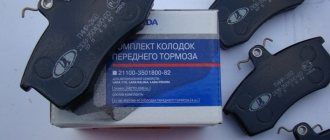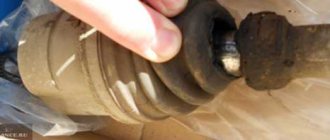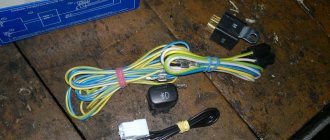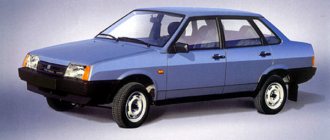Print this article Font size 16
Car breakdown is a common and commonplace situation. It is not so easy to prevent it, even if you carefully monitor all components and assemblies and carry out preventive work on time.
Each car has its own weaknesses. In the case of the VAZ 2110, these include steering tips. If they are not replaced promptly in case of damage, you may face complete destruction of the entire steering mechanism. It’s hardly worth saying what financial losses you will incur.
How do they look
What to choose?
When starting to replace tips, most owners of domestic tens ask themselves questions: which ones are better?
You have two options to choose from.
| Part type | Peculiarities |
| Factory originals | Good quality, full compliance with the design of your car. |
| Imported, manufactured under contract | There are different manufacturers, so the quality may vary. If you find a good contractor, the level of tips they produce may be higher than the factory original. But the cost will be slightly different. |
As you can see, both options have their own characteristics and advantages. So make the choice yourself.
When choosing tips, pay special attention to the quality and integrity of the rubber boot.
How to diagnose problems with tie rod ends
As mentioned above, the steering on this model consists of parts such as VAZ rods and ends, unless a special sports steering wheel is installed. The average rate of replacement of the most unstable part was also indicated. But we must take into account that the service life of steering tips on a VAZ mainly depends on the driving style of the car owner and the quality of the roads on which it is used.
Any driver can replace the steering parts of a VAZ 2110. The main symptoms indicating that the steering tips urgently need to be replaced are the following:
- the car becomes difficult to control when turning;
- At the same time, a knock is heard from one or both sides;
- When examining the tires, it becomes obvious that the tread is wearing unevenly.
The latter case may indicate not only problems in the steering, but also a possible malfunction in the front suspension system. Then it will be necessary not only to repair the ends of the VAZ 2110, but also, most likely, to change some suspension parts. On this brand of car, all steering tips are made in the form of hinged joints, wear and tear of which can lead to malfunctions that directly affect the steering. Therefore, it is advisable to check these details yourself as often as possible.
Work begins with a visual inspection, which is carried out from the left side of the car. To do this, the steering wheel of the VAZ 2110 must be turned all the way to the right. Accordingly, to inspect the right hinge, the steering column is twisted to the left. In this case, you need to pay special attention to the boot - it protects the ends mounted on the tie rods.
If there is a rupture or cracks on its surface, you must immediately begin to replace parts, since if the diameter of the holes is relatively large, then dust falling on the hinges will quickly damage them. After this, we must begin the second stage of work. The car is jacked up on one side (the wheel should rotate freely in the air). Touch the hinges with your hand.
If even minimal play is felt, then the steering tips should be completely replaced on both sides. There is no need to try to save money by replacing one part: such savings can be costly if the steering column fails on the highway.
When to change
The design of the elements is such that they are located at the ends of the steering rods. Hence the name - tips.
The rods themselves have a fairly impressive service life, so they are changed quite rarely. The same cannot be said about the tips.
If you follow the instructions provided in the instruction manual, then replacement should be performed approximately every 40 thousand kilometers. But still the figure is average. Depending on the situations, operating conditions and the quality of the currently installed elements, repairs may be required later or earlier.
The following factors influence the degree of wear of steering system components:
- Vehicle operating conditions;
- The quality of the tips used;
- Driving style of the car owner;
- Quality of roads, etc.
Signs of breakdown
At the first signs of a malfunction of the limit switches, appropriate measures should be taken to eliminate them.
You can determine that the elements are damaged and no longer perform their job as efficiently as before by the following characteristic signs:
- The car is difficult to control. This is especially noticeable when entering sharp turns;
- On tires, the tread pattern begins to wear unevenly;
- Uncharacteristic sounds are heard from the front of the car. Moreover, they can come from one side or from two simultaneously.
These signs of breakdown may indicate not only faulty steering tips. Therefore, mandatory verification is required.
Rubber boot
Which steering tips are best to choose for the VAZ 2110
Car breakdown is a common and commonplace situation. It is not so easy to prevent it, even if you carefully monitor all components and assemblies and carry out preventive work on time.
Each car has its own weaknesses. In the case of the VAZ 2110, these include steering tips. If they are not replaced promptly in case of damage, you may face complete destruction of the entire steering mechanism. It’s hardly worth saying what financial losses you will incur.
How do they look
What to choose?
When starting to replace tips, most owners of domestic tens ask themselves questions: which ones are better?
You have two options to choose from.
| Part type | Peculiarities |
| Factory originals | Good quality, full compliance with the design of your car. |
| Imported, manufactured under contract | There are different manufacturers, so the quality may vary. If you find a good contractor, the level of tips they produce may be higher than the factory original. But the cost will be slightly different. |
As you can see, both options have their own characteristics and advantages. So make the choice yourself.
When choosing tips, pay special attention to the quality and integrity of the rubber boot.
When to change
The design of the elements is such that they are located at the ends of the steering rods. Hence the name - tips.
The rods themselves have a fairly impressive service life, so they are changed quite rarely. The same cannot be said about the tips.
If you follow the instructions provided in the instruction manual, then replacement should be performed approximately every 40 thousand kilometers. But still the figure is average. Depending on the situations, operating conditions and the quality of the currently installed elements, repairs may be required later or earlier.
The following factors influence the degree of wear of steering system components:
- Vehicle operating conditions;
- The quality of the tips used;
- Driving style of the car owner;
- Quality of roads, etc.
Signs of breakdown
At the first signs of a malfunction of the limit switches, appropriate measures should be taken to eliminate them.
You can determine that the elements are damaged and no longer perform their job as efficiently as before by the following characteristic signs:
- The car is difficult to control. This is especially noticeable when entering sharp turns;
- On tires, the tread pattern begins to wear unevenly;
- Uncharacteristic sounds are heard from the front of the car. Moreover, they can come from one side or from two simultaneously.
These signs of breakdown may indicate not only faulty steering tips. Therefore, mandatory verification is required.
Rubber boot
Examination
Yes, in order to accurately determine that the limit switches are the culprit for the uncharacteristic behavior of the car, they should be checked. How to do it? Let's get a look.
- Examine the condition of the node visually. To do this, turn the steering wheel all the way to the right. This will allow you to look at the left tip. To visually inspect the right unit, you need to turn the steering wheel all the way to the left.
- Look at the rubber boot. It fits onto the tip. The presence of signs of rupture or cracks clearly indicates that the steering element needs to be replaced.
- If you do not do this, dirt will penetrate through the gaps and cracks in the boot, which will ultimately lead to very rapid wear of the part and can harm other components of your car.
- You can also lift the car with a jack by hanging the wheel in the air. Grasp the tip with your hands and shake it.
- If there is play, then the replacement will have to be performed on both sides simultaneously.
The defect is obvious
Experts strongly do not recommend changing tips individually. Even if the second element is intact, it is better to perform a double replacement.
Replacement
Well, the symptoms of the problems and a direct check of the steering mechanism elements showed that it was the tips that were to blame. Therefore you will have to change them.
Is it difficult to do? If you have at least a little experience, you have already had to disassemble the steering system, then there should not be any difficulties. By doing everything yourself, you can save a lot on the cost of service stations.
Dismantling works
To illustrate the replacement example, we advise you to rely not only on the instructions presented in our article, but also on video materials. Detailed video lessons seriously help you master quite complex stages of work.
To work you will need a set of materials and tools. It includes:
- New high quality steering limit switches;
- The almighty WD40. If you don’t have the money to buy it, use plain brake fluid;
- A set of keys;
- Pliers;
- Brush with metal bristles;
- Puller (if you don’t have a puller, replace it with a small crowbar).
Assembly of the unit
Everything you need is ready, so you can safely get to work.
- Use a jack to jack up the side of the car where you plan to do the work to replace the tie rod ends.
- Unscrew the mounting bolts from the wheel and remove it.
- Use a wire brush to clean the joint between the tip and the steering knuckle.
- If this area is heavily contaminated, the simple force of a wire brush may not be enough. This is where WD40 comes in handy. We repeat, if it is not there, try washing off the dirt with brake fluid.
- Use pliers to remove the cotter pin. It performs the task of fixing a bolted connection. A kind of fixative.
- Unscrew the fastening nut.
- Now arm yourself with a crowbar and a small hammer. Although if you managed to find a puller, it would be much better.
- Using the selected tool, you need to remove the finger of your tip from the fist of the stand. In this way, the damaged element is removed from the retainer.
- The unit to be replaced should be carefully unscrewed.
- We recommend that you first measure the current distance between the squeegee and the center of the tip. When reinstalling, this information will be extremely useful.
- Now it's time for the new kit, which you purchased in a store or ordered online.
- Insert in place of the old unit, secure with traction.
- Return the hinge pin to its rightful place - into the steering knuckle.
- Next, you should screw the nut back, tighten it properly and secure the cotter pin in the correct place.
- This instruction fully corresponds to the features of replacing the tip on another wheel. Therefore, the manual is the same for the left and right front wheel of your VAZ 2110.
- The last stage of repair will still require you to visit a service station. This is necessary in order to check the wheel alignment. The probability of its violation is too high, so do not be lazy to spend a little time and money. They shouldn't charge you much for the check.
If you do everything correctly and consistently, it will take you about an hour to replace the steering limit switches. Experienced craftsmen can do it even in 30-40 minutes. But in any case, there is no need to rush.
luxvaz.ru
Examination
Yes, in order to accurately determine that the limit switches are the culprit for the uncharacteristic behavior of the car, they should be checked. How to do it? Let's get a look.
- Examine the condition of the node visually. To do this, turn the steering wheel all the way to the right. This will allow you to look at the left tip. To visually inspect the right unit, you need to turn the steering wheel all the way to the left.
- Look at the rubber boot. It fits onto the tip. The presence of signs of rupture or cracks clearly indicates that the steering element needs to be replaced.
- If you do not do this, dirt will penetrate through the gaps and cracks in the boot, which will ultimately lead to very rapid wear of the part and can harm other components of your car.
- You can also lift the car with a jack by hanging the wheel in the air. Grasp the tip with your hands and shake it.
- If there is play, then the replacement will have to be performed on both sides simultaneously.
The defect is obvious
Experts strongly do not recommend changing tips individually. Even if the second element is intact, it is better to perform a double replacement.
How to replace steering tips on a VAZ 2110-VAZ 2112?
Removal: 1) First, remove the wheel from the side on which you need to replace the tie rod end (For information on how to remove a wheel, read the article: “Replacing a wheel on a car”), as soon as the wheel is removed from the car, remove the cotter pin from the hole when using your hands or pliers as shown in the small photo (This cotter pin prevents the castle nut from coming loose when driving a car), when the cotter pin is removed, completely unscrew the castle nut as shown in the main photo and prepare a special puller for removing ball joints from the car .
Note! When reinstalling a new tip, we recommend tightening the castle nut with a torque wrench with a torque of 27.1-33.4 N•m (2.8-3.4 kgf•m). If there is no such wrench, then either buy one (But it doesn’t cost small money, but it will always come in handy), or tighten the nut without it with a regular wrench and then go to a car service center, they will tighten the nut for you as it should!
2) Now loosen the tightening of the tie bolt (Indicated by the red arrow), due to which the tip is attached to the steering rod, when it is slightly loosened, use a special ball joint puller and, using it, remove the tip from the hole in the steering knuckle and finally, begin to rotate the steering tip itself counterclockwise until it is completely unscrewed and removed.
Note! In order to maintain the approximate alignment of the wheels and not have to go to adjust the toe-in and camber, we recommend that when unscrewing the steering tip, count how many revolutions it makes until it is completely removed from the adjusting insert!
Installation: Installation of the new tip is carried out in the reverse order of removal and do not forget, if you want to maintain the previous wheel alignment, then in this case, be sure to screw the new tip to the same number of turns and something else, the adjusting insert on which the tip is attached, is best lubricated with Litol-24 grease or something similar, then install the tip in its place, tighten the castle nut with a certain torque and secure it with a cotter pin, which after installation move in different directions, and tighten the coupling bolt to a torque of 19.1-30 .9 N•m (2.0-3.1 kgf•m) and at this point the installation of the new steering tip can be considered complete.
Additional video: You can see the process of replacing steering wheel ends in more detail in the video below:











